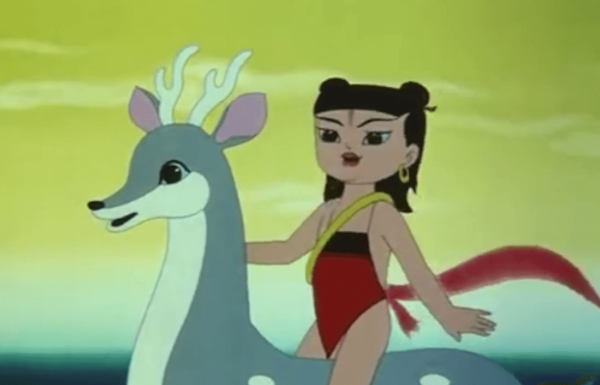5 Legendary Chinese Animations You Should Watch
- Leia Emeera

- Jul 5, 2024
- 4 min read
Updated: Jul 16
When you think of China historically or culturally, one tends to think of its archaic language, dynasties, or food. However, China does have a place in the history of animation.
Undoubtedly, animation is a form of art that has withstood the test of time. It prevails, and only improves with its eager exploration via animators. But before the products of our current advancements, what were the champions of dated animations—but more fittingly, where does China fall into this timeline?
Origins: The Pipe which Makes Fantasies Appear

Ding Huan can be credited to the invention of the Zoetrope—or at least one version of it. It dates back to 180 A.D, had he had called it “the pipe which makes fantasies appear”.
A zoetrope is an animation device that produces the illusion of motion, that works in a similar manner with the phenakisticope. Except, this device isn’t a flat, 2D piece of round cardboard. Zoetropes are a cylindrical tunnel, with an open top and slits on the sides. Spin the cylinder and peer through the slits—and you’d see a pre-film version of an animated short movie.

However, the animation industry as we know it wasn’t popularised until much later. In the year 1888, Charles-Emile Reynaud had sparked the beginnings of modern animation—to which China only picked up on in the early 1920, marking the start of donghua (Chinese Animation) culture.
A Timeline of Chinese Animations Notable Works: 1924 to 1980
1. New Year (1924)

Release date: 1924
Genre: Advertisement
Animation method: 2D Animation
Directors: Shanghai Tobacco Company
New Year is a black and white animated short movie that ran for about 2 minutes, which heeds the title of one of the donghua. It was a simple advertisement for the “Shanghai Tobacco Company”—and had little impact on the animation industry. Not much is known about the short, but its place in history is remarkable in itself.
This short piece of animation was created by Cy Young. He was a Chinese-American animator, who was hired by Disney at the recognition of his talents. His most notable works, during his time there, were “Snow White”, “Fantasia” and “Bambi”.
2. Princess Iron Fan (1941)

Release date: January 1, 1941
Genre: Fantasy, Drama
Animation method: Rotoscoping
Directors: Wan Laiming, Wan Guchan
This donghua was produced by the Wai Brothers—the pioneers of the Chinese animation industry. Unlike its peers at the time, this donghua was not an animated short movie. Instead, it carried the weight of the first animated feature film. After the success of Princess Iron Fan, these siblings went on to create many more "firsts” in their respective industry.
This movie in particular borrows an occurrence from the literary work “Journey to the West”, where the princess’s sacred fan is needed to extinguish the fires near a village—in which Sun Wukong unintentionally started. The Monkey King, and his two companions must pass the fire to continue the journey. Through rotoscoping, the titular character and Sun Wukong duels for the possession of the fan.
3. Pigsy Eats Watermelon (1958)

Release date: 1958
Genre: Fantasy, Comedy
Animation method: Paper-cut stop motion
Directors: Wan Laiming, Wan Guchan
Unsurprisingly, the Wan brothers make another appearance in this list. This time around, they had offered the animation industry a brand-new animation technique—paper-cut stop motion.
This donghua of twenty minutes followed Zhu Bajie, alluding to the literary piece “Journey to the West” once more. This half human, half pig hybrid is representative of lust, greed, and most relevantly—gluttony.
Through pieces of carefully curated paper, Pigsy is shown looking fervently for food. He finds the watermelon, splits it up to share with his disciples and leaves the biggest piece for himself, but characteristically ends up eating it all.
4. Nezha Fights the Sea (1979)

Release date: May 19, 1979
Genre: Fantasy, Drama, Action
Animation method: 2D Animation
Directors: Wang Shuchen, Yan Dingxian, Xu Jingda
Thus far, we are able to recognise a common thread within China’s animation industry—adaptations of famed Chinese literature. “Nezha Fights the Sea” is a donghua based on the novel “The Investiture of the Gods” from the era of the Ming Dynasty.
The story is set during the times of the Shang Dynasty, and includes themes like mythology, religion and philosophy. This donghua follows a prodigal character from the novel, “Nezha”, who takes on antagonistic Dragon Kings of the Four Seas.
5. Three Monks (1980)

Release date: 1980
Genre: Silent Film
Animation method: Ink-Wash Animation
Directors: Xu Jingda
This twenty minute long, ink-wash donghua is a rendition of an old Chinese proverb. With no dialogue, the story follows three monks who try to carry water back to a temple. However, their uneven weight and strength distributions makes it difficult for them to work together.
To make matters worse, in one fateful night, they awake to their temple set ablaze. This urges them to put their heads together and to settle their individual issues—to which they came up with a pulley system for their water-related needs.
Conclusion
It’s reductive to discount China from discussions of historical animations. But in recent years, donghua has been getting its long overdue praises—and it seems that this won’t be slowing down anytime soon. The Chinese animation industry has been steadily improving, and foreign collaborations have been flooding in. Ultimately, this diversity in the world of animation will surely conjure intriguing pieces in the years to come.
Author Bio
From Malaysia, Leia Emeera is a writer at TESSR, and a published author. She has been putting pen to paper ever since she learned how to, and has an anthology to her name, titled 'Ten'. Leia loves music, games and her beloved labrador retriever, George. She aims to further her studies in English Literature and Creative Writing the moment her gap year ends. 'Till then, you will find her sitting behind a desk, writing with TESSR.
Connect with her on LinkedIn: Leia Emeera


Comments